Diagnosis
INRstar has a standard set of published Diagnoses which are suitable for treatment with anticoagulation drugs. INRstar supports the following anticoagulation drugs:
- Warfarin
- Apixaban
- Dabigatran
- Dalteparin (LMWH)
- Enoxaparin (LMWH)
- Rivaroxaban
- Edoxaban
Each Warfarin diagnosis has a recommended 'Target INR' and duration of treatment. Unlisted diagnoses can be added to INRstar (see instructions below), but they will currently only be available for Warfarin treatments plans.
The following are the current standard diagnoses within INRstar.
Warfarin:
- Antiphospholipid syndrome
- Atrial fibrillation
- Dilated cardiomyopathy
- DVT (distal, non-surgical, no risk factors)
- DVT (distal, surgical, no risk factors)
- DVT (isolated calf vein)
- DVT (proximal, corrected risk factors)
- DVT (proximal, permanent risk factors)
- DVT or PE (Recurrent during treatment)
- DVT or PE (Recurrent)
- LV mural thrombus (post MI / LV aneurysm)
- Prosthetic Heart Valve (bioprosthetic, corrected risk factors)
- Prosthetic Heart Valve (bioprosthetic, mitral, no risk factors)
- Prosthetic Heart Valve (bioprosthetic, permanent risk factors)
- Prosthetic Heart Valve (mechanical, high risk)
- Prosthetic Heart Valve (mechanical, low risk)
- Prosthetic Heart Valve (mechanical, medium risk)
- Pulmonary embolus (correctable risk factors)
- Pulmonary embolus (permanent risk factors)
- Rheumatic mitral valve disease
- Thrombophilia (inherited)
Apixaban, Dabigatran, Edoxaban and Rivaroxaban:
- Atrial fibrillation
- DVT (distal, non-surgical,
no risk factors)
- DVT (distal, surgical, no
risk factors)
- DVT (isolated calf vein)
- DVT (proximal, corrected
risk factors)
- DVT (proximal, permanent
risk factors)
- DVT or PE (Recurrent during
treatment)
- DVT or PE (Recurrent)
- Pulmonary embolus
(correctable risk factors)
- Pulmonary embolus
(permanent risk factors)
Dalteparin (LMWH):
- Antiphospholipid syndrome
- Atrial fibrillation
- Dilated cardiomyopathy
- DVT (distal, non-surgical,
no risk factors)
- DVT (distal, surgical, no
risk factors)
- DVT (isolated calf vein)
- DVT (proximal, corrected
risk factors)
- DVT (proximal, permanent
risk factors)
- DVT or PE (Recurrent during
treatment)
- DVT or PE (Recurrent)
- LV mural thrombus (post MI
/ LV aneurysm)
- Prosthetic Heart Valve
(bioprosthetic, corrected risk factors)
- Prosthetic Heart Valve
(bioprosthetic, mitral, no risk factors)
- Prosthetic Heart Valve (bioprosthetic, permanent risk factors)
- Prosthetic Heart Valve
(mechanical, high risk)
- Prosthetic Heart Valve
(mechanical, low risk)
- Prosthetic Heart Valve
(mechanical, medium risk)
- Pulmonary embolus
(correctable risk factors)
- Pulmonary embolus
(permanent risk factors)
- Rheumatic mitral valve
disease
- Thrombophilia (inherited)
Important Note:
Do not add a new diagnosis if the only difference is the Target INR. Use the patient's individual Treatment Plan to set the specific, non-standard Target INR.
If you do need to add a new diagnosis, you must be logged into INRstar as the Organisation Clinical Lead. The available main menu options will be:

Navigate to the Options tab.
Select the Diagnosis tab.
To add an unlisted diagnosis, click the 'Add Diagnosis' button.

Enter the following fields:
- Diagnosis' Name.
- Diagnosis' Target INR.
- Diagnosis' Treatment Duration.
- Drug
- Warfarin is always selected and cannot be unselected
- You can add none, one or multiple drugs to a new custom diagnosis
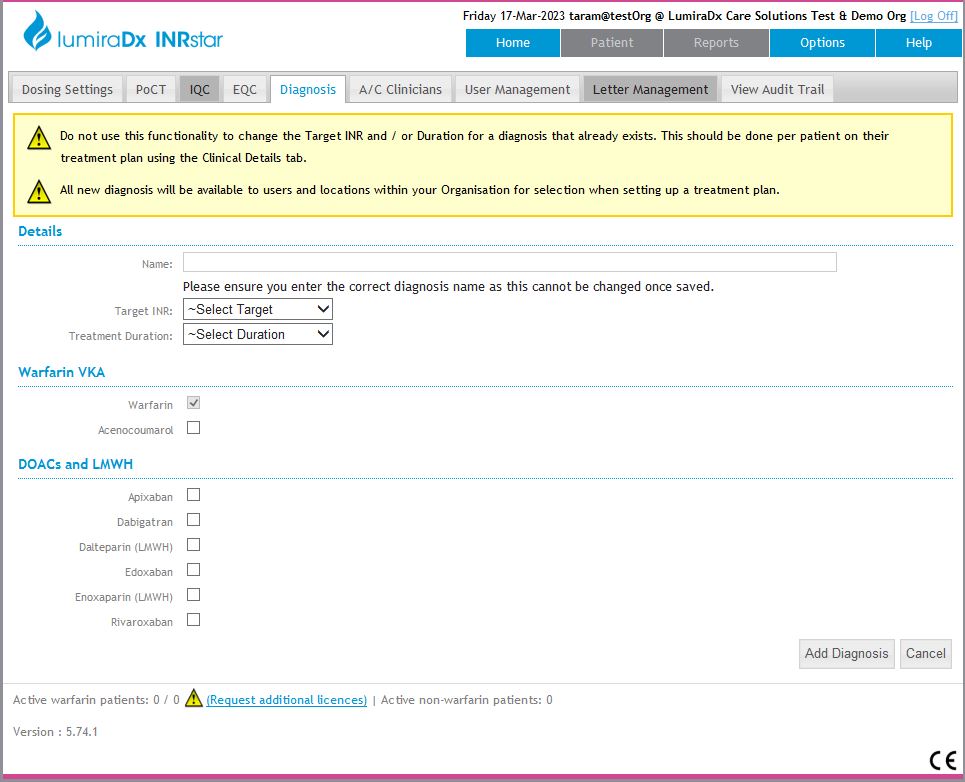
To save the new Diagnosis, click the 'Add Diagnosis' button.
To edit a diagnosis select the one you need from the dropdown list.
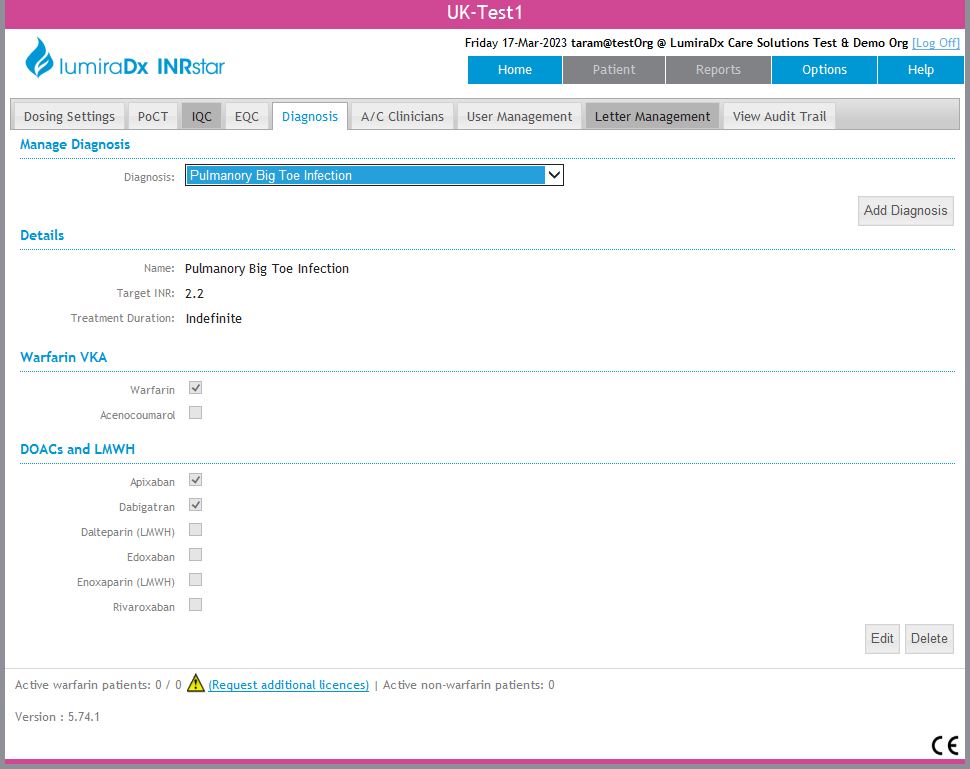
At the bottom of the screen click the 'Edit' button.
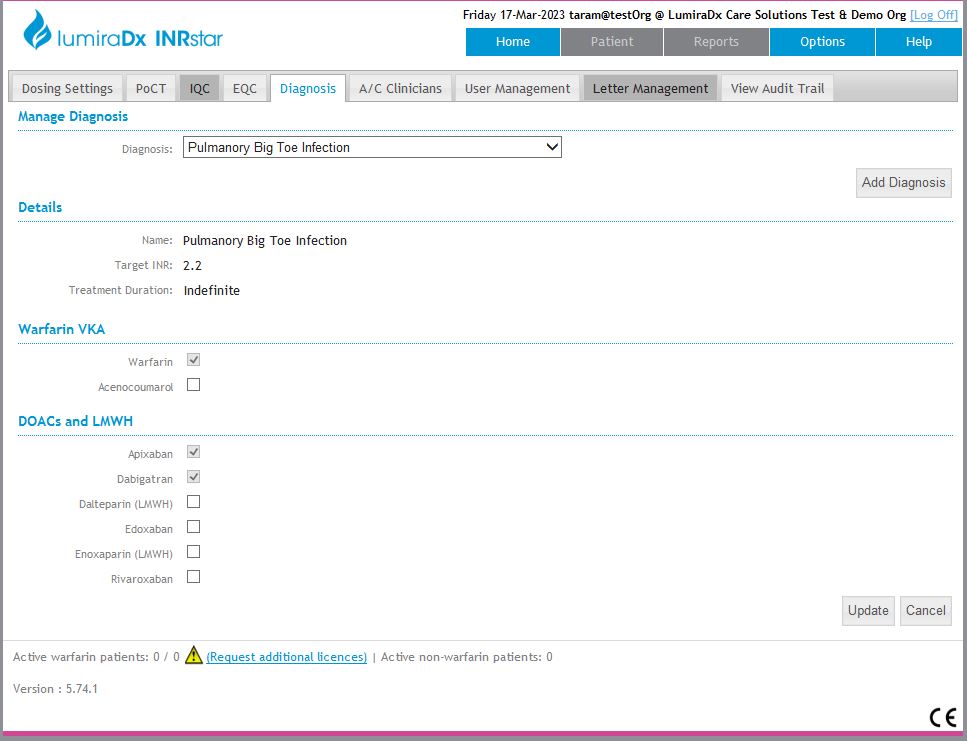
It is only possible to add a new drug to the diagnosis you cannot removed one. It is no longer possible to edit Target INR or Treatment Duration or Diagnosis Name.
Then click the 'Update' button.
Only custom or edited standard diagnoses can be deleted. If a previously edited standard diagnosis is deleted, it will be replaced with the original standard diagnosis.
To delete a custom diagnosis, click the 'Delete' button.
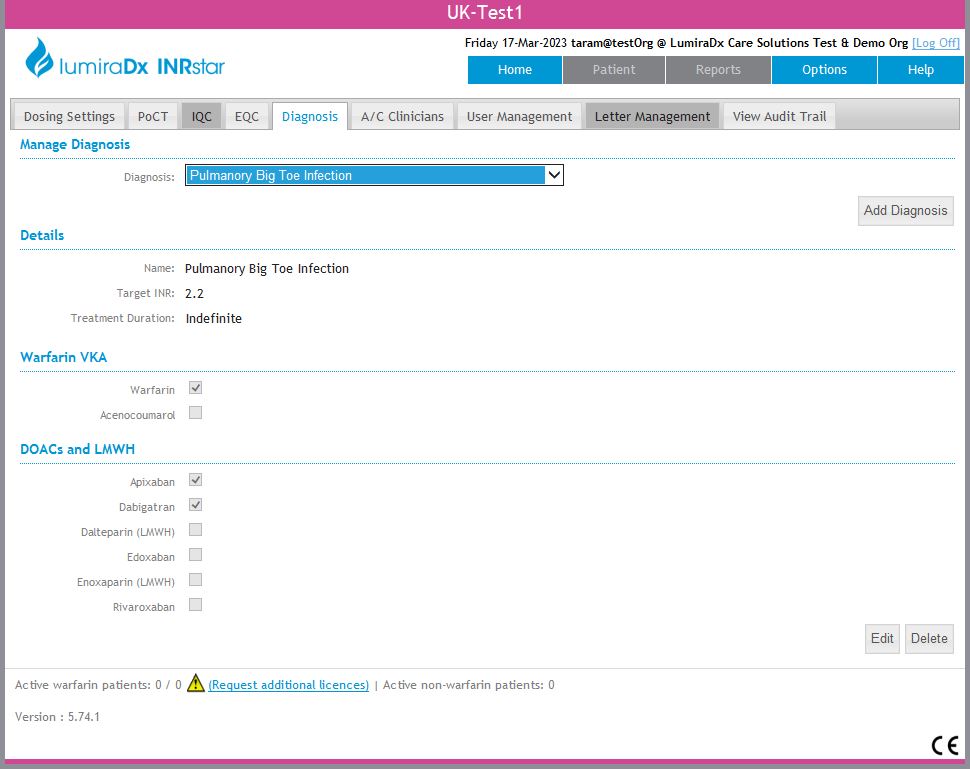
A confirmation message will be displayed. Click the 'Confirm' button to confirm deleting the diagnosis, or click the 'Cancel' button to cancel the deletion.
If there is an active patient within your Organisation with this diagnosis the following message is also displayed.
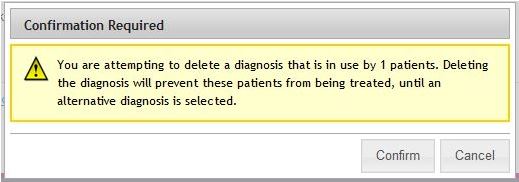
Click the 'Confirm' button to confirm deleting the diagnosis, or click the 'Cancel' button to cancel the deletion
